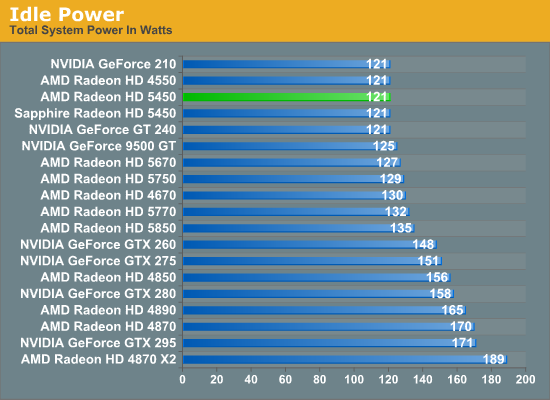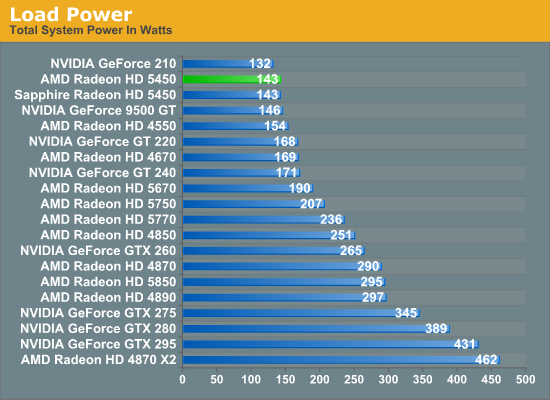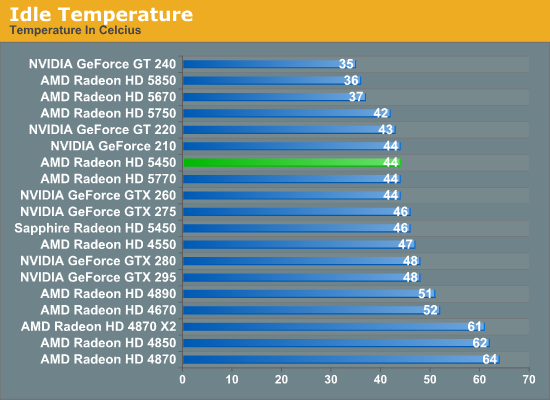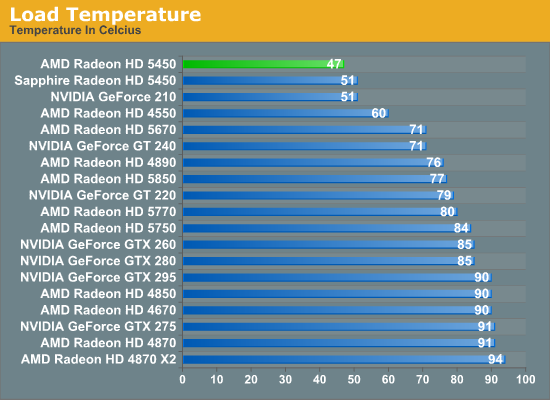AMD’s Radeon HD 5450: The Next Step In HTPC Video Cards
by Ryan Smith on February 4, 2010 12:00 AM EST- Posted in
- GPUs
Power & Temperatures
While entry-level video cards may not top the performance charts, their low transistor count and low power usage means that they do very well on our power and temperature charts. And by being passively cooled, they are winners by default for noise, as they don’t generate any noise to measure.


On paper these cards differ by around a few watts when it comes to idle power, but by the time you put them in our i7 test rig, those few watts melt away. The Radeon 5450, the Radeon 4550, and the GeForce 210 all idle at 121W on our test rig, tying with the GeForce GT 240 for the lowest idle power usage we’ve measured.
Under load this changes some. The 5450 offers the second-lowest load power usage that we’ve measured, coming in below things like the GT 220 and the 4550. It doesn’t quite best the GeForce 210 however, which we believe to be a combination of the 210’s smaller-yet GPU and differences to how NVIDIA and AMD go about throttling their cards when we’re running FurMark.
At any rate, the 5450 does particularly well against other AMD cards, not only beating the 4000-series, but coming in under the 5670 by a hefty 47W. The 5670 may be the better HTPC card from a deinterlacing standpoint right now, but you pay for it with power.


We should note that for our load temperature testing, we use a closed case with all of the fans active on our Thermaltake Spedo case. So the results here are from plenty of airflow being sent towards the first PCIe x16 slot. Since we’re looking at passive cards today, they’re much more affected by this than actively cooled cards are. In a case with little to no airflow, these passive cards would definitely get hotter.
For load temperatures, the 5450 is the coolest video card we have ever tested, taking the title by 4C over its nearest competitor, the GeForce 210. This is thanks in a large part to the use of a double-wide heatsink for better heat dissipation, and of course the low power consumption of the 5450 in the first place. This also gives us a chance to quantify the differences between the double-wide heatsink on the reference card and the single-wide heatsink on the Sapphire 5450; the smaller Sapphire heatsink is only 4C worse at 51C. The double-wide heatsink in this case looks to be overkill.
At idle things change some. Our coolest cards are the actively cooled cards, which have their own fans to keep them cool. The passively cooled cards on the other hand build up some additional heat, coming in at the mid-40s, similar to several of our mid-range cards.










77 Comments
View All Comments
andy o - Thursday, February 4, 2010 - link
So far the most reasonable explanation I've seen by googling is someone if a forum suggesting that its function is just disabling certain features so as to prioritize smooth playback over those features. I don't see any difference with the 5770, otherwise (with that card it doesn't disable anything).UNCjigga - Thursday, February 4, 2010 - link
I sort of assumed it was similar to what 120hz/240hz LCD TVs do: use a frame doubler to more closely match your monitor's refresh rate and give the impression of "smooth" motion.andy o - Thursday, February 4, 2010 - link
I don't think so, most PC displays are 60 Hz, and I think even most 120 Hz TVs only take up to 60p input. There's only a couple of 120Hz-input monitors.therealnickdanger - Wednesday, February 10, 2010 - link
Actually, most CRTs using analog connections are capable of 120Hz. DVI, HDMI, and DisplayPort do not support digital transmission speeds over 60Hz. It's a sad state of affairs if you ask me.sc3252 - Thursday, February 4, 2010 - link
I know this isn't exactly supposed to be a fast card, but its clocked ~10% faster yet its slower than the last generation card... I can't say I am surprised though, after seeing the 5770 clocked faster than the 4870 yet being around the same speed.StevoLincolnite - Thursday, February 4, 2010 - link
I think people are missing allot of the big picture here and that's Crossfire with the Radeon 54xx series.Specifically with the new 8 series of chipsets, hence the amount of shaders present, I expect a return of Hybrid Crossfire.
Pairing an IGP with a low-end card is a very cost effective solution to getting more performance out of a system and also gives AMD an edge in getting more people to buy an AMD Processor+Chipset+Graphics card.
ereavis - Thursday, February 4, 2010 - link
"me too" I'd dig a 758G Hybrid Crossfire review with this and the other sub $100 Radeons (if they support x-fire) 785 was a great motherboard to match with the Athlon II and Phenom II X2-X3, some of us were waiting on video card purchases and would like to see Crossfire 54XX/56XX compared to a 5750 discrete for example.JarredWalton - Friday, February 5, 2010 - link
Fun fact: HD 5450 is about 40% faster than my pathetic old 7600 GT in my work PC. Remember when 6600 GT was da bomb? LOLQuietOC - Thursday, February 4, 2010 - link
The 80 shader discrete Radeons are just too limited by 64-bit DDR3. The 785G has more bandwidth and the same number of ROPS (mine even runs fine at 1GHz.) If they had cut the power usage of the 5450 down a lot more it may have made some sense.Totally - Thursday, February 4, 2010 - link
5770 128-bit bus, 4870 256-bit busagain 5450 64-bit bus, 4550 128-bit bus